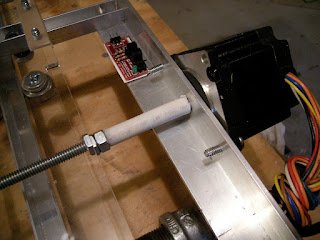The Structure Is Built
The basic McWire cartesian structure has been built. The last step was to couple the drive screws to the motors. I was undecided on the way to do this. The stepper motors I have a D shaft. I was a little concerned about using the suggested aquarium tubing with them. I was in the hardware store on my way to find some tubing and I came across the PEX pipe. It's a semi rigid plastic pipe. It was cheap and very sturdy. It's even rated for hot potable water so I though i would give it a try. I meant to pick up some tubing as well as a fall back incase this didn’t work but, I was so focused on making the PEX pipe work, I forgot.
The Coupler
It's 3/8" OD and ID about 7/32". At first, I tried to slide it on the the motor shaft with a good amount of pressure but it was a no go. The motor shaft diameter is a 1/4" so I drilled it out to 15/64" and tried it again. No joy there either. Then I tried a 1/4"drill. Finally the motor shaft slid in - but not without a significant amount of pressure.
I decided to use a 2" piece for the coupler. This would allow 3/4" for the motor shaft and 1" for the threaded rod with a 1/4" gap between. On the drive screw side I tapped it about 3 turns worth of 1/4"-20 and then using a jam nut configuration screwed the threaded bar into the pipe about an inch. Looking back I think 1/2" would have done but the wheels were already in motion.
On the final assembly I kept the jam nuts on the rod to help get the pipe off if ever I need too.
Yet Another Spacer
I discovered another place a spacer is needed. When I attached the coupling nut using the 1/2" conduit strap to the X and Y platforms, the added assembly was running into the end support. I lowered the end support from the rails with 1/4" of PEX pipe for a spacer. This was only a problem on the X and Y as the Z coupling nut assembly is not at the end of the platform.
Another option was to take off the end support completely as it seems it's only function is to hold the opto-endstop and I think that could be done in a different fashion. For now I will leave it.
Subscribe to:
Post Comments (Atom)




5 comments:
Would you mind identifying what stepper motors did you choose and why?
I picked NEMA 23 motors for this project because eventually this will become a CNC with a Dremel type of cutter and I wanted to be sure it had enough power to push hard enough to cut. I am certainly not a motor expert I just figured bigger would be better. I ordered them from MakerBot. I think they might be overkill for a repstrap with a plastruder.
My aim, longer term, is to build a Mendel Apollo potentially using much of the hardware from my McWire. I believe it is intended that Nema 17 motors are used for the Mendel Apollo. But I also wanted to put my Dremel on the end of my McWire in the short term.
I haven't done any calculations, but I suspect that for a Dremel based device more torque will be required to accomodate the mass of the cutting head and forces experienced by the tool.
I have no qualms about re-designing the mountings for a Mendel Apollo though if its feasible to accomodate the different footprints.
I will be interested in the performance of your imperial leadscrews. The pitch of my metric lead screws is 1mm (0.0394"). My beasty could take forever to advance the stages. I shall look up the performance of the motor today and see what the effect might be.
I plan to measure the backlash and overall positional accuracy of my device when its constructed to see what performance I can expect. I suspect as the extruded plastics diameters and thus footprints, are so large compared to the positional control that it does not matter too much for extruded plastics. But I would like to mill some PCB's and I believe that this will require a good level of repeatability and accuracy.
From some of the videos I have seen, milling anything other than very simple PCB's may be out of the question.
One thing that attracted me to the McWire setup is that it is easily accessed for changes. It's very open as in not a lot of things in the way. Changing out different screws would be easy one the structure is built. I think that it would be possible to have both NEMA 17 and 23 motor hole patterns in the end supports.
Pex is incredibly strong. In addition, if you can find a friendly plumber, there are crimp fittings that are warranted to hold it in place for 30 years or so.
Post a Comment